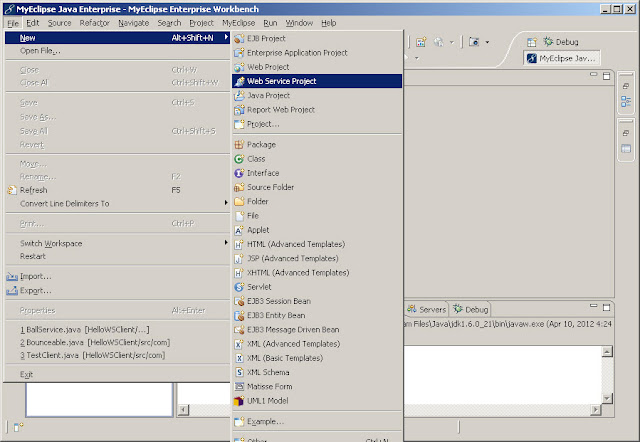Web services are platform independent hence it is used to communicate between different languages over http protocol. Web Services can convert your application into a Web-application, which can publish its function or message to the rest of the world. The basic Web Services platform is XML and HTTP.
Publishing and Consuming a Helloworld web service is very easy, all you need to have is a JDK (1.6 or higher),a Tomcat server and a IDE (e.g. Eclipse) to create a web service client you need to download stub. In this article we will see how to publish a simple JAX-WS web services using Tomcat servlet container. Also we will see how to create a simple web serive client. i.e. How to consume web service?
How to publish simple web service?
For running this example, below mentioned particulars are used.
- Tomcat 7.0.11
- JDK 1.6.0_21
- MyEclipse 8.6
Please go through each of the screen shots.
Creating a New Web Service Project

Add project name, lets say SimpleWebservice
/* HelloWS.java */
package com.javaxp;
import javax.jws.WebService;
import javax.jws.soap.SOAPBinding;
@WebService
@SOAPBinding(style = SOAPBinding.Style.RPC)
public interface HelloWS {
public String sayHello(String name);
}
/* HelloWSImpl.java */
package com.javaxp;
import javax.jws.WebService;
@WebService(endpointInterface="com.javaxp.HelloWS")
public class HelloWSImpl implements HelloWS {
public String sayHello(String name) {
return "Hello "+name+"!! this is your first web service.";
}
}
web.xml (defines WSServletContextListener)
${Tomcat}/webapps/SimpleWebservice/WEB-INF/web.xml
<?xml version="1.0" encoding="UTF-8"?>
<web-app version="2.5"
xmlns="http://java.sun.com/xml/ns/javaee"
xmlns:xsi="http://www.w3.org/2001/XMLSchema-instance"
xsi:schemaLocation="http://java.sun.com/xml/ns/javaee
http://java.sun.com/xml/ns/javaee/web-app_2_5.xsd">
<listener>
<listener-class>
com.sun.xml.ws.transport.http.servlet.WSServletContextListener
</listener-class>
</listener>
</web-app>
sun-jaxws.xml (defines web service implementation class)
${Tomcat}/webapps/SimpleWebservice/WEB-INF/sun-jaxws.xml
<?xml version="1.0" encoding="UTF-8"?>
<endpoints
xmlns="http://java.sun.com/xml/ns/jax-ws/ri/runtime"
version="2.0">
<endpoint
name="HelloWS"
implementation="com.javaxp.HelloWSImpl"
url-pattern="/hellows"/>
</endpoints>
If JAXB is not bundled with your tomcat you have to add below mentioned JAR files in ${Tomcat}/lib.
Download JAR file from https://jax-ws.java.net/
- gmbal-api-only.jar
- ha-api.jar
- jaxb-impl.jar
- jaxws-api.jar
- jaxws-rt.jar
- jaxb-api.jar
- management-api.jar
- policy.jar
- stax-ex.jar
- streambuffer.jar
- jaxb-core.jar
Now deploy your web service project to tomcat and hit below mentioned URL, you should able to see below screen shot.
http://localhost:8080/SimpleWebservice/hellows
WSDL Url
http://localhost:8080/SimpleWebservice/hellows?wsdl
Below is the generated XML.
This XML file does not appear to have any style information associated with it. The document tree is shown below.
−
<!--
Published by JAX-WS RI at http://jax-ws.dev.java.net. RI's version is JAX-WS RI 2.2.6b21 svn-revision#12959.
-->
−
<!--
Generated by JAX-WS RI at http://jax-ws.dev.java.net. RI's version is JAX-WS RI 2.2.6b21 svn-revision#12959.
-->
−
<definitions targetNamespace="http://javaxp.com/" name="HelloWSImplService">
<types/>
−
<message name="sayHello">
<part name="arg0" type="xsd:string"/>
</message>
−
<message name="sayHelloResponse">
<part name="return" type="xsd:string"/>
</message>
−
<portType name="HelloWS">
−
<operation name="sayHello">
<input wsam:Action="http://javaxp.com/HelloWS/sayHelloRequest" message="tns:sayHello"/>
<output wsam:Action="http://javaxp.com/HelloWS/sayHelloResponse" message="tns:sayHelloResponse"/>
</operation>
</portType>
−
<binding name="HelloWSImplPortBinding" type="tns:HelloWS">
<soap:binding transport="http://schemas.xmlsoap.org/soap/http" style="rpc"/>
−
<operation name="sayHello">
<soap:operation soapAction=""/>
−
<input>
<soap:body use="literal" namespace="http://javaxp.com/"/>
</input>
−
<output>
<soap:body use="literal" namespace="http://javaxp.com/"/>
</output>
</operation>
</binding>
−
<service name="HelloWSImplService">
−
<port name="HelloWSImplPort" binding="tns:HelloWSImplPortBinding">
<soap:address location="http://localhost:8080/SimpleWebservice/hellows"/>
</port>
</service>
</definitions>
How to consume a web service?
Consuming a web service is very easy all you need to have a WSDL url and an IDE i.e Eclipse for creating web service client. Provide WSDL url and download the stubs. Below mentioned files are automatically generated by WSDL.
Lets create a simple web service client.
Step by step process to create web service client. Please see the screen shots below.
Add project name, lets say SimpleWebserviceClient
Now creating a client.
Add WDSL URL http://localhost:8080/SimpleWebservice/hellows?wsdl
Now stubs are downloaded. You should able to see below mentioned classes.
HelloWS.java (exposed interface)
HelloWSImplService.java (generated class)
Now we will creata TestClient.java
/* TestClient.java */
package com.javaxp;
public class TestClient {
public static void main(String[] args) {
HelloWSImplService service = new HelloWSImplService();
HelloWS helloWS = service.getHelloWSImplPort();
System.out.println(helloWS.sayHello("Madan"));
}
}
Output










